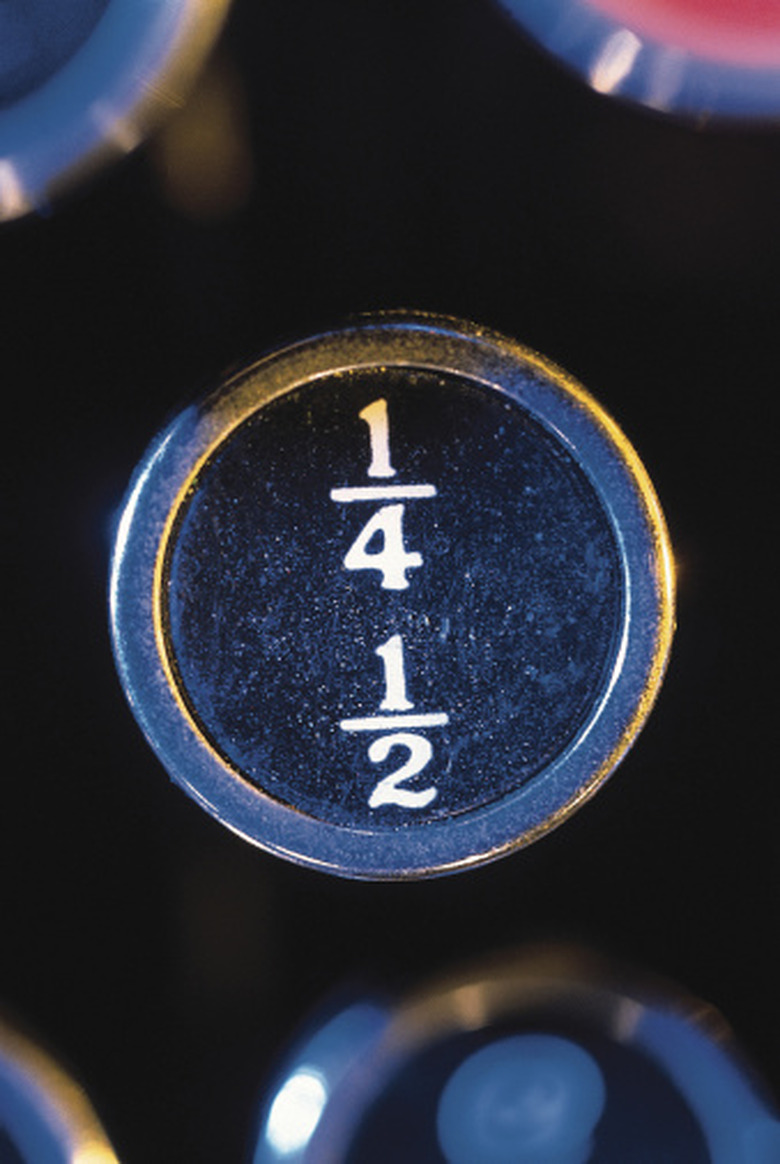How To Divide Fractions With Ease
If fractions have you all tied up in knots, wondering how to divide fractions with ease, the good news is this: if you you can multiply you can divide fractions. As long as you know that a reciprocal fraction is just a fraction turned upside down so that, for instance, 3/4 becomes 4/3, and that a whole number over one is equal to the whole number, such as 5 equals 5/1, then dividing fractions should be a breeze. To divide mixed number fractions, you will have to convert it to an improper fraction before proceeding with the simple division algorithm. A few practice problems and you will be a master at dividing fractions without blinking an eyelash.
Simple Fractions
Step 1
Read the fraction division problem such as 3/4 ÷ 5/8. Invert the second fraction to form the reciprocal so 5/8 becomes 8/5.
Step 2
Rewrite the first fraction and the reciprocal of the second as a multiplication sentence 3/4 x 8/5.
Step 3
Multiply the numerators together, then the denominators: 3 x 8 is 24 and 4 x 5 is 20. Therefore, the answer is 24/20.
Step 4
Reduce the answer to lowest terms. 24 ÷ 20 equals 1 4/20. The greatest common factor (GCF) of 4 and 20 is 4 so divide the numerator and denominator by the GCF to simplify it and find the final answer, 1 1/5.
Fractions and Whole Numbers
Step 1
Read a fraction division problem such as 9/15 ÷ 3. Write 3 as 3/1 and invert to get 1/3 as the reciprocal.
Step 2
Write the equation 9/15 x 1/3.
Step 3
Multiply the numerators and denominators: 9 x 1 is 9 and 15 x 3 is 45 making the product 9/45.
Step 4
Find the GCF of 9 and 45, which in this case is 9. Divide both numbers by 9 to find the final, simplified answer: 1/5.
Mixed Numbers
Step 1
Read a fraction division problem such as 8 1/9 ÷ 5/10. Convert the mixed number to an improper fraction by multiplying the denominator by the whole number, 9 x 8 is 72. Add the numerator, 72 + 1 is 73. The denominator remains the same so 8 1/9 equals 73/9.
Step 2
Invert the second fraction so 5/10 becomes 10/5.
Step 3
Rewrite the equation as a multiplication sentence with the improper fraction and the reciprocal, 73/9 x 10/5.
Step 4
Multiply the numerators and denominators: 73 x 10 equals 730 and 9 x 5 equals 45 so the product is 730/45.
Step 5
Divide the numerator by the denominator. The remainder is the numerator in the resulting mixed number, 16 10/45. Divide the new numerator and denominator by the GCF to reduce the fraction to lowest terms. The GCF of 10 and 45 is 5 so the final answer is 16 2/9.
TL;DR (Too Long; Didn't Read)
For a tutorial on finding the greatest common factor to help reduce fractions to lowest terms, try Math Playground's "Factor Trees" exercise or AAA Math's drills.
References
- AAA Math: Dividing Fractions by Fractions; J. Banfill; 2009
- Math is Fun: Dividing Fractions; 2010
- Homeschool Math: Dividing Fractions 2a: How Many Times Does It Fit?; Maria Miller; 2011
- AAA Math: Dividing Fractions by Whole Numbers; J. Banfill; 2009
- AAA Math: Dividing Mixed Numbers; J. Banfill; 2009
Cite This Article
MLA
Hooser, Tamara Christine Van. "How To Divide Fractions With Ease" sciencing.com, https://www.sciencing.com/divide-fractions-ease-5658279/. 24 April 2017.
APA
Hooser, Tamara Christine Van. (2017, April 24). How To Divide Fractions With Ease. sciencing.com. Retrieved from https://www.sciencing.com/divide-fractions-ease-5658279/
Chicago
Hooser, Tamara Christine Van. How To Divide Fractions With Ease last modified March 24, 2022. https://www.sciencing.com/divide-fractions-ease-5658279/
